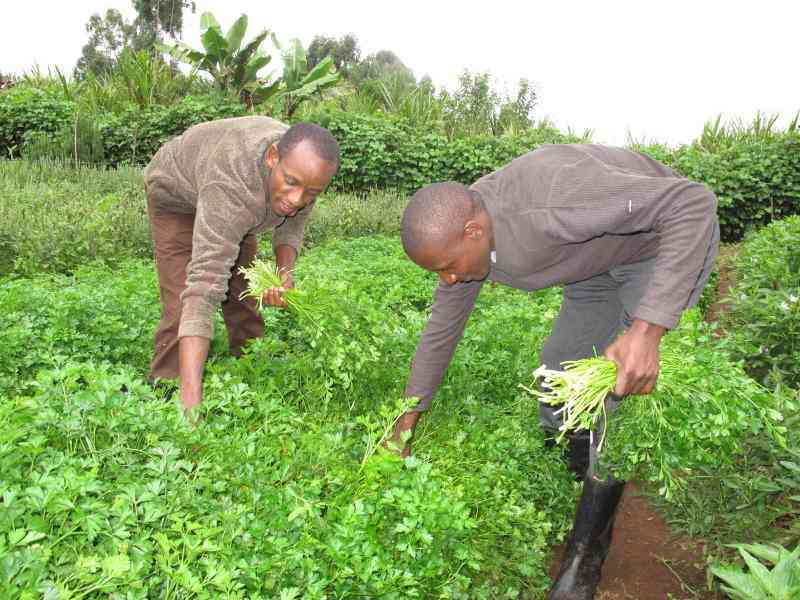Miraa farmers in Meru have raised an alarm over harmful pests that are ravaging the crop.
Miraa supports thousands of farmers and their families in Igembe North, Igembe Central, Igembe South and parts of Tigania East Sub-counties.
They said the pests had reduced yields, calling for the government's intervention.
Already, county agricultural officials have put in place measures to fight the pests, but the farmers say more needs to be done.
Julius Kiogora and William Mithika, officers from the county government's Kaguru Farmers Training Centre, said flying sensors had been deployed in various areas where miraa farms are under serious threat.
Problem
“A major pest is called red scales, which sucks branches and causes the leaves to dry. But there is also fisirium wilt, which is harmful to the crop. The infrared flying sensors are flown over the farms and are able to detect stressed areas. After the problem has been identified thorugh this technology, the pests are sprayed with chemicals,” said Mr Mithika.
Mr Mugwika said if action is not taken quickly, they would have little to sell locally and for external markets like Somalia.
About 11,000 hectares is under miraa. This is double the area occupied by coffee (5,659 hectares), according to Meru County figures for 2017.
“Pests are a serious issue for miraa farmers. Efforts should be made to kill the pests ravaging miraa farms," said Justus Mugwika, a farmer.
Mr Kiogora said with the infrared flying sensors, they have been able to "see the strains or stresses" in farms and advised farmers accordingly.
“We have done it for many farmers in miraa growing areas and identified stresses like nutrition and water stresses, pests and diseases,” he said.
Mithika warned the presence of pests in miraa zones is a real threat to get high-grade miraa.
Mithika said over 5,000 farmers had so far been helped to identify pests and remedial measures were ongoing.
Meru County Crop Development Officer Phyllis Mutungi said they were waiting for agronomic guidance from Kenya Agricultural and Livestock Research Organisation.
Stay informed. Subscribe to our newsletter
Tsetse fly eradication
Elsewhere, the national government has launched a tsetse fly eradication exercise in two constituencies in Busia County.
The development comes as a relief to residents of Obekai, Kwangamor, Kakapel, Apatit in Teso South Constituency and Kapesor Katotoi in Teso North Constituency, who have been complaining about the blood-sucking insects.
Residents and animals are being screened and treated against human trypanosomiasis also known as sleeping sickness and nagana, respectively, by experts from the Kenya Tsetsefly and Trypanosomiasis Education Council.
The council’s chair Robert Monda said Obekai was highly infested with the insects.
In 2009, Obekai hit the headlines after a villager, Jacinter Iserem, was diagnosed with sleeping sickness. She was declared free from the disease after two months of treatment at the Alupe Sub-county hospital.
Alupe in Teso South constituency is the country’s only referral hospital for sleeping sickness.
 The Standard Group Plc is a
multi-media organization with investments in media platforms spanning newspaper
print operations, television, radio broadcasting, digital and online services. The
Standard Group is recognized as a leading multi-media house in Kenya with a key
influence in matters of national and international interest.
The Standard Group Plc is a
multi-media organization with investments in media platforms spanning newspaper
print operations, television, radio broadcasting, digital and online services. The
Standard Group is recognized as a leading multi-media house in Kenya with a key
influence in matters of national and international interest.
 The Standard Group Plc is a
multi-media organization with investments in media platforms spanning newspaper
print operations, television, radio broadcasting, digital and online services. The
Standard Group is recognized as a leading multi-media house in Kenya with a key
influence in matters of national and international interest.
The Standard Group Plc is a
multi-media organization with investments in media platforms spanning newspaper
print operations, television, radio broadcasting, digital and online services. The
Standard Group is recognized as a leading multi-media house in Kenya with a key
influence in matters of national and international interest.








